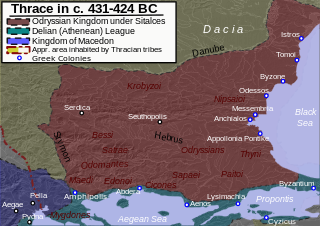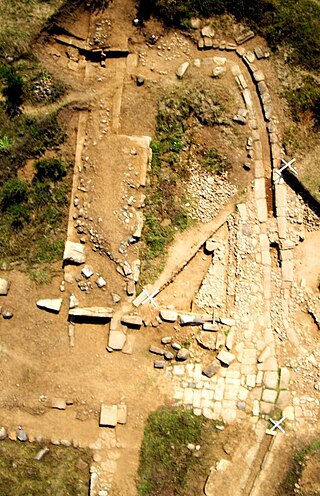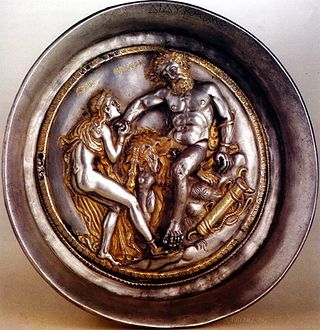Tourism in Bulgaria is a significant contributor to the country's economy. Situated at the crossroads of the East and West, Bulgaria has been home to many civilizations: Thracians, Greeks, Romans, Eastern Romans or Byzantines, Slavs, Bulgars, and Ottomans. The country is rich in tourist sights and historical artifacts, scattered through a relatively small and easily accessible territory. Bulgaria is internationally known for its seaside and winter resorts.
Cotys I or Kotys I was a king of the Odrysians in Thrace from 384 BC to his murder in 360 BC. He was known to have been born during the reign of Seuthes I, based on ancient sources and date of birth estimates for Cotys, his daughter who married the Athenian general Iphicrates, and her son Menestheus. According to Harpokration, he reigned for 24 years, which places his accession in 384 BC. Although his origins are actually unknown, An Athenian inscription dated to 330 BC, which honors Reboulas, brother of Cotys and son of king Seuthes. As the ordinal of Seuthes is not mentioned, it was unclear, however, which of the preceding kings named Seuthes is meant by the inscription. While scholars originally believed Seuthes II to be the father of Cotys I, now it is known that Seuthes I was his father, as Seuthes II was only 7 years old at the time of Seuthes I's abdication in 411 BC.

The Thracians were an Indo-European speaking people who inhabited large parts of Southeast Europe in ancient history. Thracians resided mainly in Southeast Europe in modern-day Bulgaria, Romania and northern Greece, but also in north-western Anatolia in Turkey.

The Odrysian kingdom was an ancient Thracian state that thrived between the early 5th century BC and the early 3rd / late 1st century BC. Located in present-day Bulgaria, southeastern Romania, northern Greece and European Turkey, it was a tribal amalgam dominated by the Odrysians that was the first large political entity to develop in the eastern Balkans. Before the foundation of Seuthopolis in the late 4th century it had no fixed capital.
Borovo is a town in Ruse Province, Northern Bulgaria. It is the administrative centre of the homonymous Borovo Municipality. As of December 2009, the town has a population of 2,330 inhabitants.

Pistiros was an inland Ancient Greek emporion, or trade center, in Ancient Thrace. It is located near the modern city of Vetren, in the westernmost part of the Maritsa River valley.
Amadocus was an Odrysian ruler in Thrace, who ruled from 360 to c. 351 BC.
Hebryzelmis was an Odrysian king of Thrace, attested as ruling in 386/385 BC.

The Thracians were a group of Indo-European tribes inhabiting a large area in Central and Southeastern Europe, centred in modern Bulgaria. They were bordered by the Scythians to the north, the Celts and the Illyrians to the west, the Greeks to the south, and the Black Sea to the east.

The Panagyurishte Treasure is a Thracian treasure.

The Rogozen Treasure, called the find of the century, is a Thracian treasure.

The Valchitran Treasure is an early Thracian treasure.

Seuthes III was a king of Odrysia, a part of Thrace, during the late 4th century BC.

The Lukovit Treasure is a silver Thracian treasure.
Teres II or Teres III was a king of the Odrysians in Thrace from 351 BC to 341 BC.
Cotys II was a possible king of the Odrysians in Thrace in the late 4th or early 3rd century BC. His one secure attestation is in an inscription from Athens dated to 330 BC; the inscription honored Reboulas, brother of Cotys and son of Seuthes. This is generally interpreted to mean that Cotys, not yet king, was the son of Seuthes III by a marriage earlier than that to Berenike. Building on this interpretation of the evidence, a certain Gonimase (Gonimasē), wife of a Seuthes, buried in a tomb near Smjadovo, has been proposed as Seuthes III's earlier wife and mother of Cotys and Reboulas. However, the Athenian inscription precedes the first clear attestation of Seuthes III by about seven years, and various scholars have proposed Seuthes I, Seuthes II, and even a non-reigning Seuthes as the father of Cotys and Reboulas. One scholar conjectures that Cotys was an elder son of Seuthes III but did not live to succeed his father, dying during the siege of Callatis (Mangalia) in 310 BC. While it is likely that Cotys II was a Thracian ruler in this period, it is not possible to establish his precise relationship to Seuthes III. The overall chronology and the names suggest the possibility that Cotys II may have been the father of Raizdos and grandfather of the latter's son Cotys III.
Cotys III was a king of the Odrysians in Thrace in the early 3rd-century BC. His one secure attestation is an inscription from Delphi dated to sometime between 276 and 267 BC, in which he is named as the son of Raizdos, his probable predecessor. Scholarship has long associated a coin type struck for a king Cotys on one side and a king Rhescuporis on the other and also a king Cotys, father of a Rhescuporis, named in a decree from Apollonia (Sozopol) with Cotys III. However, these identifications have been doubted, and some scholars have redated both the coin type and the inscription to almost three centuries later. It is therefore uncertain whether Cotys III was succeeded by a son named Rhescuporis.

The gold wreaths from Thrace are jewellery wreaths found in inner Thrace, which is within present day Bulgaria. The gold wreaths were found in the mounds and tombs of aristocrats at various locations in Thrace that have been dated to a period from the latter half of the fourth century and early part third century BC.
Thrace Foundation is a non-profit organisation that supports the preservation of cultural heritage in Bulgaria and the world at large.














